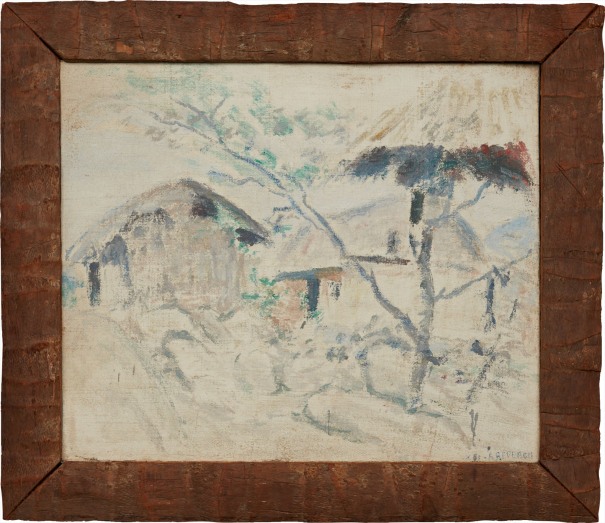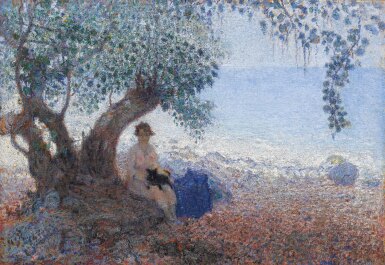Armando Reverón Desnudo 1939 oil and tempera on burlap 41 1/2 x 38 1/2 in. (105.4 x 97.8 cm) Signed "Armando Reverón" lower left. We wish to thank the Proyecto Armando Reverón (PAR) for their kind assistance in confirming the authenticity of this lot. This lot will be included in the forthcoming Catalogue Raisonné being prepared by the Proyecto Armando Reverón (PAR).
Provenance Colletion of Felipe S. Casanova, Caracas CDS Gallery, New York Acquired directly from the above by the present owner Exhibited Caracas, Museo de Bellas Artes, Retrospectiva de Armando Reverón July 1955 Caracas, Museo de Arte Contemporáneo de Caracas, December 1977 Caracas, Galería de Arte Nacional, El lugar de los objetos, 2001 New York, Museum of Modern Art, Armando Reverón February 11 - April 16, 2007 Literature Restrospectiva de Armando Reverón exh.cat., Museo de Bellas Artes, Caracas, 1955, n.p. (illustrated) J. Calzadilla, Armando Reverón Caracas, 1979, p. 212 (illustrated) El lugar de los objetos, exh.cat., Galería de Arte Nacional, Caracas, 2001, p. 169 (illustrated) J. Elderfield and L. Pérez-Oramas, Armando Reverón exh.cat., New York, 2007, p.146 (illustrated) Catalogue Essay Armando Reverón was born into a wealthy family in Venezuela in 1889. At a very early age he became interested in art, which at the time in Venezuelan was not considered an acceptable profession by upper society. Despite this, the young artist proved to be so talented that he battled against social pressures and continued to study painting, eventually winning a scholarship to study in Spain. In Spain, Reverón studied with some of the best painters of the time, including Ignacio Zuloaga Reverón submerged himself in art, endlessly returning to the Museo del Prado and absorbing all he could from the European painters represented there. His influences ranged from Cézanne and Monet to magnificent Spanish painters like Goya and the genre painter, Joaquín Sorolla. A work that particularly impressed Reverón was Goya’s La maja desnuda, 1979-1800, which inspired his best known painting, The Cave, 1920. This seminal work was the first portrait Reverón painted of his beloved Juanita Ríos, a young woman of Indian and Spanish descent, who would become Reverón’s lifelong partner. Reverón met Juanita when he returned from Europe and joined an anti-academic group of artists called the Círculos de Bellas Artes, who were declared enemies of the state by the Venezuelan government. The group eventually broke up causing Reverón to retreat to a tiny village called Macuto with Juanita in order to escape government persecution. To live in an isolated village with a woman of indigenous descent was quite atypical for a man of high society in Venezuela and his family did not approve. It was during this time that Reverón had his first mental breakdown and as a result was diagnosed with schizophrenia. Turning to Reverón’s early works – landscapes and portraits defined as the Blue Period – we see that the artist was working with a decidedly blue palette and was influenced by the Russian painter, Nicolás Ferdinandov who lived briefly with Reverón and became a good friend. In these paintings, Reverón denotes mystery through blue hues and intimations of Goya, working in that tradition of well-known Spanish painters. Reverón’s landscapes established him within respected artistic circles and won him recognition, ultimately defining his unique brand of modernism. Following this period, the artist drastically renovated his pictorial style, changing his palette to highly textured monochromatic white hues, applying white paint to white burlap canvases, with only hints of pale blue to highlight opulent effects or reflect shadows, all of which bordered on abstraction. Reverón was known for using very specific brushes and in general disliked the touch of metal and newly manufactured materials. Hence, Reverón used bamboo brushes or ones that he crafted himself of out pencils and made his own canvases out of burlap sacks. The subject matter of these landscapes was the surrounding beaches of the artist’s native Venezuela and many included what became a recognizable iconography of grape trees and seascapes. This was also the time when Reverón began using a singular technique to expose sections of the canvas for representational purposes, emulating a sensation of being blinded
Armando Reverón Desnudo 1939 oil and tempera on burlap 41 1/2 x 38 1/2 in. (105.4 x 97.8 cm) Signed "Armando Reverón" lower left. We wish to thank the Proyecto Armando Reverón (PAR) for their kind assistance in confirming the authenticity of this lot. This lot will be included in the forthcoming Catalogue Raisonné being prepared by the Proyecto Armando Reverón (PAR).
Provenance Colletion of Felipe S. Casanova, Caracas CDS Gallery, New York Acquired directly from the above by the present owner Exhibited Caracas, Museo de Bellas Artes, Retrospectiva de Armando Reverón July 1955 Caracas, Museo de Arte Contemporáneo de Caracas, December 1977 Caracas, Galería de Arte Nacional, El lugar de los objetos, 2001 New York, Museum of Modern Art, Armando Reverón February 11 - April 16, 2007 Literature Restrospectiva de Armando Reverón exh.cat., Museo de Bellas Artes, Caracas, 1955, n.p. (illustrated) J. Calzadilla, Armando Reverón Caracas, 1979, p. 212 (illustrated) El lugar de los objetos, exh.cat., Galería de Arte Nacional, Caracas, 2001, p. 169 (illustrated) J. Elderfield and L. Pérez-Oramas, Armando Reverón exh.cat., New York, 2007, p.146 (illustrated) Catalogue Essay Armando Reverón was born into a wealthy family in Venezuela in 1889. At a very early age he became interested in art, which at the time in Venezuelan was not considered an acceptable profession by upper society. Despite this, the young artist proved to be so talented that he battled against social pressures and continued to study painting, eventually winning a scholarship to study in Spain. In Spain, Reverón studied with some of the best painters of the time, including Ignacio Zuloaga Reverón submerged himself in art, endlessly returning to the Museo del Prado and absorbing all he could from the European painters represented there. His influences ranged from Cézanne and Monet to magnificent Spanish painters like Goya and the genre painter, Joaquín Sorolla. A work that particularly impressed Reverón was Goya’s La maja desnuda, 1979-1800, which inspired his best known painting, The Cave, 1920. This seminal work was the first portrait Reverón painted of his beloved Juanita Ríos, a young woman of Indian and Spanish descent, who would become Reverón’s lifelong partner. Reverón met Juanita when he returned from Europe and joined an anti-academic group of artists called the Círculos de Bellas Artes, who were declared enemies of the state by the Venezuelan government. The group eventually broke up causing Reverón to retreat to a tiny village called Macuto with Juanita in order to escape government persecution. To live in an isolated village with a woman of indigenous descent was quite atypical for a man of high society in Venezuela and his family did not approve. It was during this time that Reverón had his first mental breakdown and as a result was diagnosed with schizophrenia. Turning to Reverón’s early works – landscapes and portraits defined as the Blue Period – we see that the artist was working with a decidedly blue palette and was influenced by the Russian painter, Nicolás Ferdinandov who lived briefly with Reverón and became a good friend. In these paintings, Reverón denotes mystery through blue hues and intimations of Goya, working in that tradition of well-known Spanish painters. Reverón’s landscapes established him within respected artistic circles and won him recognition, ultimately defining his unique brand of modernism. Following this period, the artist drastically renovated his pictorial style, changing his palette to highly textured monochromatic white hues, applying white paint to white burlap canvases, with only hints of pale blue to highlight opulent effects or reflect shadows, all of which bordered on abstraction. Reverón was known for using very specific brushes and in general disliked the touch of metal and newly manufactured materials. Hence, Reverón used bamboo brushes or ones that he crafted himself of out pencils and made his own canvases out of burlap sacks. The subject matter of these landscapes was the surrounding beaches of the artist’s native Venezuela and many included what became a recognizable iconography of grape trees and seascapes. This was also the time when Reverón began using a singular technique to expose sections of the canvas for representational purposes, emulating a sensation of being blinded



.jpg)











Try LotSearch and its premium features for 7 days - without any costs!
Be notified automatically about new items in upcoming auctions.
Create an alert